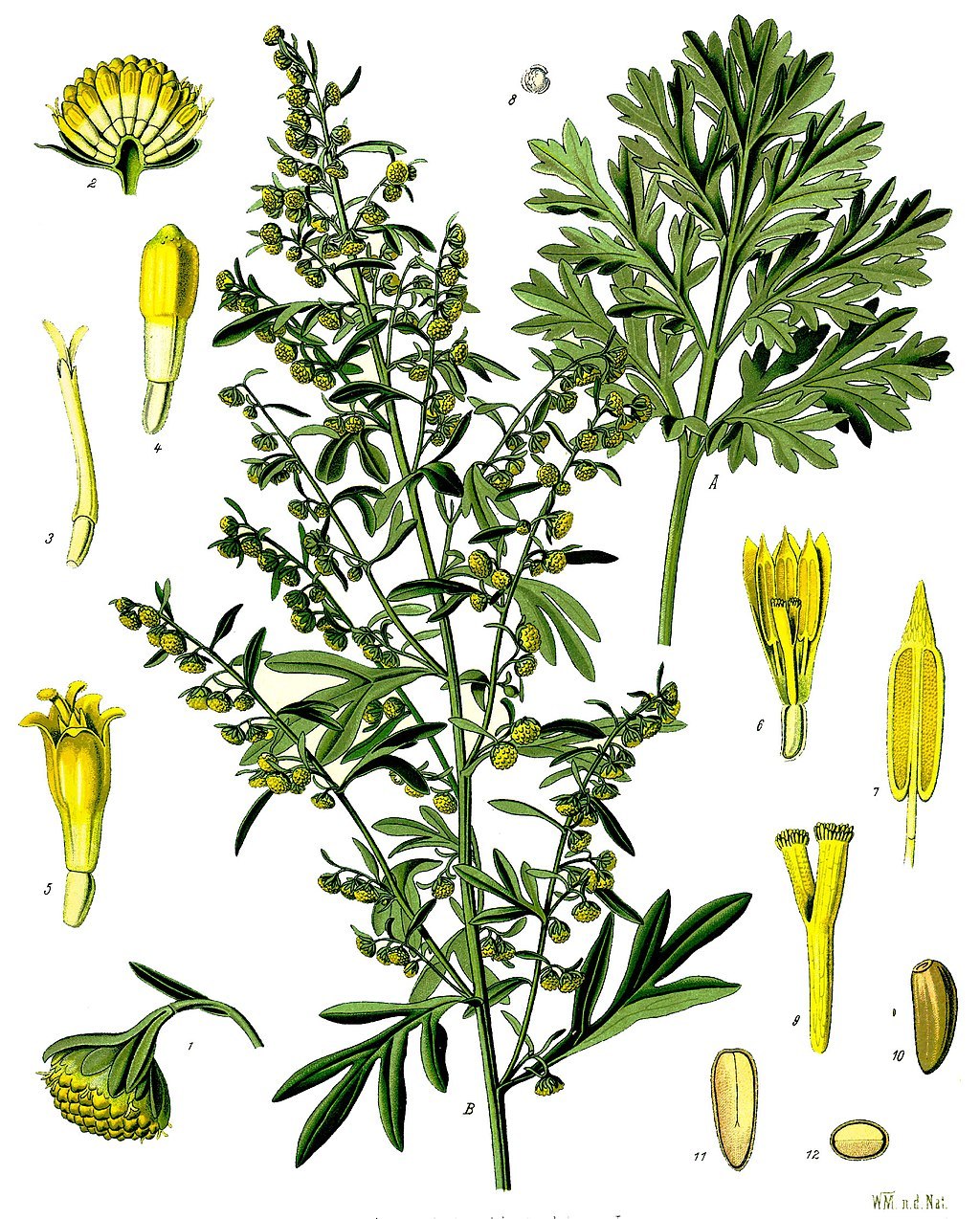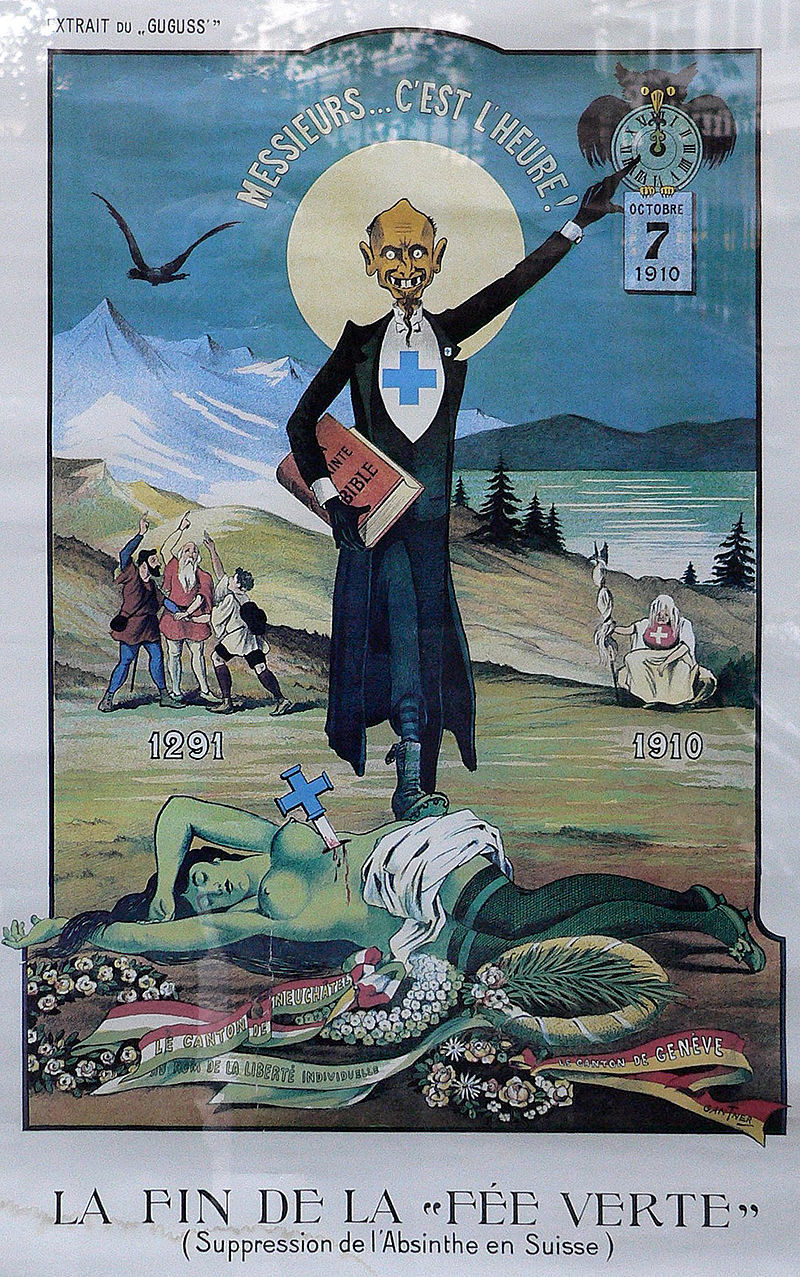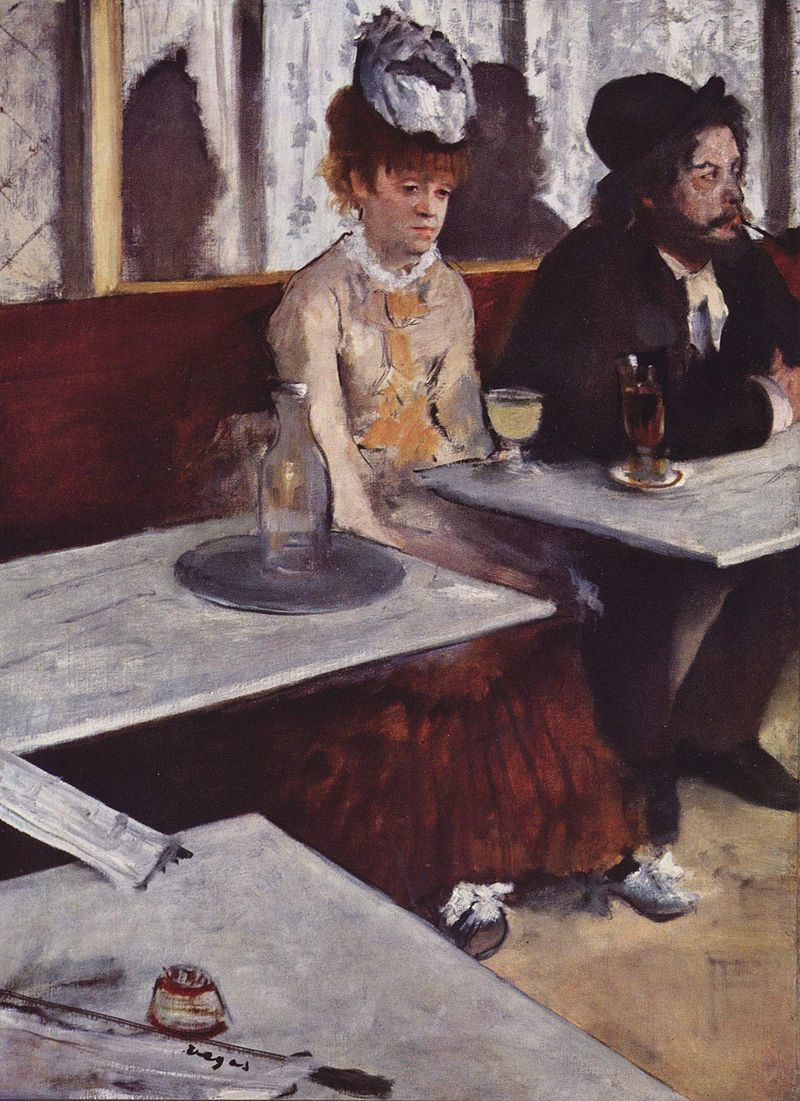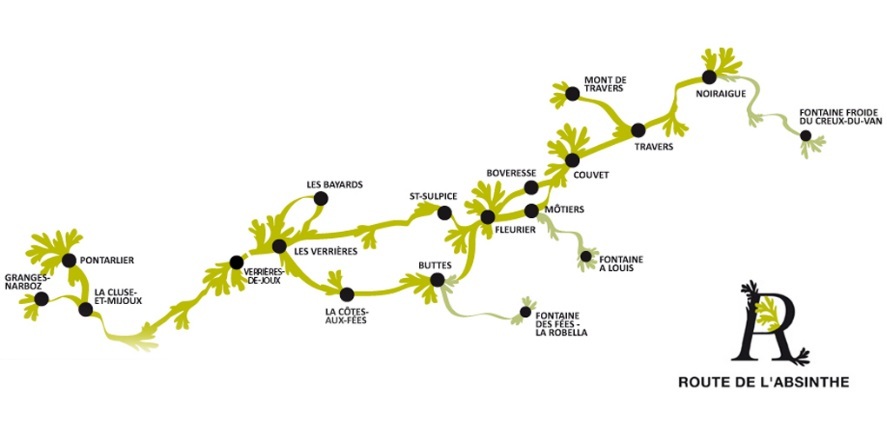
Neuchâtel: l’Absinthe
Ce nom résonne dans le canton de Neuchâtel depuis XVIIIe siècle.
La Plante
Cette plante dont voici la classification APG III, est utilisé dans la composition du spiritueux du même nom.
|
Classification APG III (2009)
|
 |
|
Régne
|
Pantae
|
|
Clade
|
Angiospermes
|
|
Clade
|
Dicotylédones vraies
|
|
Clade
|
Noyau des Dicotylédones vraies
|
|
Clade
|
Astéridées
|
|
Clade
|
Campanulidées
|
|
Ordre
|
Asterales
|
|
Famille
|
Asteraceae
|
|
Sous-famille
|
Asteroideae
|
|
Tribu
|
Anthemideae
|
|
Sourtribu
|
Artemisiinae
|
|
Genre
|
Artemisia
|
|
Espèce
|
|
Artemisia absinthium
L., 1753
|
Histoire
Origine incertaine, mais dès l'Egypte ancienne, son usage médical est mentionné dans le Papyrus Ebers (entre -1600 et -1500 av. J.-C.). Les Grecs Pythagore et Hippocrate (460-377 av. J.-C.) la décrive comme un alcool et son action sur la santé: effet aphrodisiaque et stimulant la création. Les Grecs ancien consommaient également du vin aux extraits d’absinthe. Elle est la favorite de la déesse grecque Artémis qui inspira son nom, l’Artemesia absinthium L. (grande absinthe) (ainsi que pour la petite absinthe: l’Artemesia Pontica).
La plante de l’absinthe est utilisée de tous temps pour ses vertus médicinales aujourd’hui confirmées ; antiseptique, vermifuge et stimulante, elle est indiquée en cas d’insuffisance de suc gastrique, circulation sanguine et excrétion biliaire.
Dans l’antiquité, elle fut même utilisée comme antidote au poison ainsi que pour ses vertus abortives.
Vers le XVIIIe siècle, la trace de distillerie apparaisse dans le canton de Neuchâtel et spécialement dans le village de Couvet (Commune de Val-de-travers). A ces début, la boisson reste régionale entre Pontarlier et Neuchâtel. Lors de la colonisation de l’Algérie par les Français, elle fut utilisé pour passer le désagréments de la malaria et de la dysenterie. Les soldats, à leur retour en France, popularisent cette boisson à travers tout le pays.
Titrant autour de 70°, elle se boit diluer dans des verres hauts et larges.
Dans les année 1850, elle est relativement coûteuse et devient la “fée verte”. Vers 1870 elle représente 90% des apéritifs consommés en France. Jusqu’au début de la première guerre mondiale, la production explose et les prix chute drastiquement. La production passe de 700’000 litres en 1874 à 36’000’000 litre en 1910.
Des absinthes de piètre qualité, surnommées “sulfates de zinc” en raison de la coloration obtenue grâce à ce composé chimique, prolifèrent.
Son interdiction arrivera en 1910 en Suisse et en 1915 en France car les ligues de vertu disaient d’elle “qu’elle rend fou et criminel, fait de l’homme une bête et menace l’avenir de notre temps”. Mais l’objectif premier fut de lutter contre l'alcoolisme.

Le 1er mars 2005 en Suisse, l’absinthe est ré-autorisé, la France autorisera en 2011.
La “absinthe” , la “Fée verte” et “la Bleue” deviennent des indication géographique protégée suisse (IGP).
Produits dérivés
L’absinthe est principalement connu comme spiritueux mais elle est aussi consommée dans des essaies après vieillissement dans des fûts de vin comme un whisky ou comme ingrédients dans des recettes pour chocolats, pâtisseries, charcuteries, boissons aromatisées utilisent cet alcool et la plante.
Arts
L’absinthe a aussi inspirée l’Arts, voici quelques exemples:
-
Les peintres comme Édouard Manet pour la peinture “Le Buveur d’absinthe”, L'Absinthe de Vincent Van Gogh ou L'Absinthe ou Portrait du poète Cornuti est une aquarelle de Pablo Picasso.
-
La sculpture: “Le Verre d’Absinthe” par Pablo Picasso.
-
La littérature: Émile Zola dans “L’Assommoir”, “Les buveurs d’absinthe” par Octave Féré et Jules Cuvain,
-
La chanson: Barbara chante “l’Absinthe” en 1972, Nine Inch Nails en fait clairement référence dans son clip vidéo du titre “The Perfect Drug”.
-
Poésie: “Je suis la fée verte” par Marie Corelli.
-
Cinéma: Jean Gabin boit un absinthe dans le film “French Cancan”.

Ce descriptif est loin d'être exhaustif. Vous trouverez de plus ample information via le net comme la route de l'absinthe qui fait découvrir la région franco-suisse de Pontarlier à Neuchâtel.

Voici les conditions pour valider cette cache,
1- Au point zéro de la cache, vous trouverez sous la boite aux lettres grise de l'administration un texte à noter qui commence par "GC892J3" et finit par "RCA85", veuillez, m’envoyer la réponse soit par la messagerie, soit par l’email suivant rca85geocaching@gmail.com.
2- Une photo de vous avec un objet relatif à l’absinthe sera appréciée mais pas obligatoire.
En l'absence de réponse à la question 1, le log sera effacé sans indication de ma part.

Neuchâtel: l’Absinthe
Dieser Name ist im Kanton Neuenburg seit dem 18. Jahrhundert in aller Munde.
Die Anlage
Diese Pflanze, die die Klassifizierung APG III hat, wird in der Zusammensetzung der gleichnamigen Spirituose verwendet.
|
Classification APG III (2009)
|
 |
|
Régne
|
Pantae
|
|
Clade
|
Angiospermes
|
|
Clade
|
Dicotylédones vraies
|
|
Clade
|
Noyau des Dicotylédones vraies
|
|
Clade
|
Astéridées
|
|
Clade
|
Campanulidées
|
|
Ordre
|
Asterales
|
|
Famille
|
Asteraceae
|
|
Sous-famille
|
Asteroideae
|
|
Tribu
|
Anthemideae
|
|
Sourtribu
|
Artemisiinae
|
|
Genre
|
Artemisia
|
|
Espèce
|
|
Artemisia absinthium
L., 1753
|
Geschichte
Sein Ursprung ist ungewiss, aber bereits im alten Ägypten wird seine medizinische Verwendung im Papyrus Ebers erwähnt (zwischen -1600 und -1500 v. Chr.). Die Griechen Pythagoras und Hippokrates (460-377 v. Chr.) beschrieben ihn als einen Alkohol und seine Wirkung auf die Gesundheit: aphrodisierende Wirkung und anregende Schöpfung. Auch die alten Griechen tranken Wein mit Absinth-Extrakten. Es ist der Liebling der griechischen Göttin Artemis, die den Namen Artemesia absinthium L. inspirierte. (großer Wermut) (sowie für den zierlichen Wermut: Artemesia Pontica).
Die Wermutpflanze wird seit jeher wegen ihrer heutzutage bestätigten medizinischen Tugenden verwendet; sie ist antiseptisch, wurmhemmend und anregend und wird bei unzureichender Magensaft-, Durchblutungs- und Gallenausscheidung angezeigt.
In der Antike wurde es sogar als Gegenmittel gegen Gift sowie für seine abtreibenden Tugenden verwendet.
Um das 18. Jahrhundert taucht die Spur der Destillerie im Kanton Neuenburg und insbesondere im Dorf Couvet (Gemeinde Val-de-travers) auf. In diesen Anfängen bleibt das Getränk regional zwischen Pontarlier und Neuenburg. Während der Kolonisierung Algeriens durch die Franzosen wurde sie benutzt, um die Unannehmlichkeiten von Malaria und Ruhr zu überwinden. Soldaten, bei ihrer Rückkehr nach Frankreich, popularisiert dieses Getränk im ganzen Land.
Bei einer Titration um 70° wird er verdünnt in hohen und breiten Gläsern getrunken.
In den 1850er Jahren war es relativ teuer und wurde zur "grünen Fee". Um 1870 stellt er 90% der in Frankreich konsumierten Aperitife dar. Bis zum Beginn des Ersten Weltkriegs explodierte die Produktion und die Preise fielen drastisch. Die Produktion ging von 700.000 Litern im Jahr 1874 auf 36.000.000 Liter im Jahr 1910.
Absinthe von schlechter Qualität, die wegen der durch diese chemische Verbindung erzielten Färbung den Spitznamen "Zinksulfate" tragen, vermehren sich.
Sie wurde 1910 in der Schweiz und 1915 in Frankreich verboten, weil die Tugendbündnisse sagten, dass sie "verrückt und kriminell macht, den Menschen zur Bestie macht und die Zukunft unserer Zeit bedroht". Aber das Hauptziel war der Kampf gegen den Alkoholismus.

Am 1. März 2005 wurde Absinth in der Schweiz wieder zugelassen, Frankreich wird es 2011 genehmigen.
"Absinth", "Fée verte" und "la Bleue" werden zur geschützten geografischen Angabe der Schweiz.
Derivative Produkte
Absinth ist hauptsächlich als Spirituose bekannt, aber er wird auch in Essenzen nach der Reifung in Weinfässern als Whisky oder als Zutat in Rezepten für Schokolade, Gebäck, Aufschnitt, aromatisierte Getränke konsumiert, die diesen Alkohol und die Pflanze verwenden.
Kunts
Absinth hat auch die Kunst inspiriert, hier ein paar Beispiele:
-
Maler wie Édouard Manet für das Gemälde "Le Buveur d'absinthe", L'Absinthe von Vincent Van Gogh oder L'Absinthe ou Portrait du poète Cornuti ist ein Aquarell von Pablo Picasso.
-
Die Skulptur: "Das Absinth-Glas" von Pablo Picasso.
-
Literatur: Émile Zola in "L'Assommoir", "Les buveurs d'absinthe" von Octave Féré und Jules Cuvain,
-
Der Song: Barbara singt 1972 "Absinth", Nine Inch Nails bezieht sich in ihrem Videoclip zu "The Perfect Drug" deutlich darauf.
-
Poesie: "Ich bin die grüne Fee" von Marie Corelli.
-
Kino: Jean Gabin trinkt Absinth in dem Film "French Cancan".

Diese Beschreibung ist bei weitem nicht erschöpfend. Im Netz finden Sie weitere Informationen, wie z.B. die Absinth-Route, die Sie die französisch-schweizerische Region von Pontarlier bis Neuchâtel entdecken lässt.

Hier sind die Bedingungen für die Validierung dieses Caches,
1- Am Nullpunkt des Caches finden Sie unter der graue Mailbox der Verwaltung einen zu notierenden Text, der mit "GC892J3" beginnt und mit "RCA85" endet, bitte senden Sie mir die Antwort entweder über die Mailbox oder über die folgende E-Mail rca85geocaching@gmail.com..
2- Ein Bild von Ihnen mit einem Absinth-bezogenen Objekt wird geschätzt, ist aber nicht zwingend erforderlich.
Falls die Frage 1 nicht beantwortet wird, wird das Protokoll ohne meinen Hinweis gelöscht.

Neuchâtel: l’Absinthe
This name has resounded in the canton of Neuchâtel since the 18th century.
The Plant
This plant, which has an APG III classification, is used in the composition of the spirit of the same name.
|
Classification APG III (2009)
|
 |
|
Régne
|
Pantae
|
|
Clade
|
Angiospermes
|
|
Clade
|
Dicotylédones vraies
|
|
Clade
|
Noyau des Dicotylédones vraies
|
|
Clade
|
Astéridées
|
|
Clade
|
Campanulidées
|
|
Ordre
|
Asterales
|
|
Famille
|
Asteraceae
|
|
Sous-famille
|
Asteroideae
|
|
Tribu
|
Anthemideae
|
|
Sourtribu
|
Artemisiinae
|
|
Genre
|
Artemisia
|
|
Espèce
|
|
Artemisia absinthium
L., 1753
|
History
Its origin is uncertain, but as early as Ancient Egypt, its medical use is mentioned in the Papyrus Ebers (between -1600 and -1500 BC). The Greeks Pythagoras and Hippocrates (460-377 B.C.) described it as an alcohol and its action on health: aphrodisiac effect and stimulating creation. The ancient Greeks also drank wine with absinthe extracts. It is the favourite of the Greek goddess Artemis who inspired its name, Artemesia absinthium L. (grand wormwood) (as well as for the petite wormwood: Artemesia Pontica).
The wormwood plant has been used since time immemorial for its medicinal virtues, which are nowadays confirmed; antiseptic, vermifuge and stimulant, it is indicated in case of insufficient gastric juice, blood circulation and biliary excretion.
In antiquity, it was even used as an antidote to poison as well as for its abortifacient virtues.
Around the 18th century, the trace of distillery appears in the canton of Neuchâtel and especially in the village of Couvet (Commune of Val-de-travers). At these beginnings, the drink remains regional between Pontarlier and Neuchâtel. During the colonization of Algeria by the French, it was used to get over the inconveniences of malaria and dysentery. Soldiers, on their return to France, popularized this drink throughout the country.
Titrating around 70°, it is drunk diluted in tall and wide glasses.
In the 1850s, it was relatively expensive and became the "green fairy". Around 1870 it represents 90% of the aperitifs consumed in France. Until the beginning of the First World War, production exploded and prices fell drastically. Production went from 700,000 litres in 1874 to 36,000,000 litres in 1910.
Poor quality absinthes, nicknamed "zinc sulphates" because of the coloration obtained thanks to this chemical compound, proliferate.
It was banned in 1910 in Switzerland and in 1915 in France because the Leagues of Virtue said that it "drives mad and criminal, makes man a beast and threatens the future of our time". But the primary objective was to fight against alcoholism.

On March 1st 2005 in Switzerland, absinthe is re-authorized, France will authorize it in 2011.
Absinthe", "Fée verte" and "la Bleue" become Swiss Protected Geographical Indication (IGP).
Derivative products
Absinthe is mainly known as a spirit but it is also consumed in trials after aging in wine casks as a whisky or as an ingredient in recipes for chocolates, pastries, sausages, flavoured drinks use this alcohol and the plant.
Arts
Absinthe has also inspired the Arts, here are a few examples:
-
Painters like Édouard Manet for the painting "Le Buveur d'absinthe", L'Absinthe by Vincent Van Gogh or L'Absinthe ou Portrait du poète Cornuti is a watercolour by Pablo Picasso.
-
The sculpture: "The Absinthe Glass" by Pablo Picasso.
-
Literature: Émile Zola in "L'Assommoir", "Les buveurs d'absinthe" by Octave Féré and Jules Cuvain,
-
The song: Barbara sings "Absinthe" in 1972, Nine Inch Nails clearly refers to it in her video clip "The Perfect Drug"
-
Poetry: "I am the green fairy" by Marie Corelli.
-
Cinema: Jean Gabin drinks absinthe in the movie "French Cancan".

This description is far from being exhaustive. You will find more information on the net such as the absinthe route which makes you discover the Franco-Swiss region from Pontarlier to Neuchâtel.

Here are the conditions to validate this cache,
1- At the zero point of the cache, you will find under the gray mailbox of the administration a text to note that begins with "GC892J3" and ends with "RCA85", please, send me the answer either by email or by the following email rca85geocaching@gmail.com..
2- A picture of you with an absinthe-related object will be appreciated but not obligatory.
In the absence of an answer to question 1, the log will be deleted without any indication from me.
Virtual Rewards 2.0 - 2019/2020
This Virtual Cache is part of a limited release of Virtuals created between June 4, 2019 and June 4, 2020. Only 4,000 cache owners were given the opportunity to hide a Virtual Cache. Learn more about Virtual Rewards 2.0 on the Geocaching Blog.
Learn how to solve a Rubix Cube with the beginner method, using only six algorithms.